Abstract
Twenty one adult patients with asthma, with positive skin test responses to the European house dust mite, Dermatophagoides pteronyssinus, were randomly allocated to a control group or to a group applying house dust mite avoidance measures. These included an initial application of liquid nitrogen to mattresses and bedroom carpets to kill the live house dust mite population. Histamine airway responsiveness, symptom scores, peak expiratory flow rates (PEF), and house dust mite numbers were determined during the two week pretrial and eight week trial periods. Nine patients in each group completed the study. By the end of the study there was a significant reduction in live mites in the "avoidance" group but not in the control group. The avoidance group showed a significant improvement in symptom scores measured on a linear analogue scale, in the number of hours each day spent wheezing (mean reduced from 8.6 to 4.5 hours), and in PEF (l/min) both in the morning (from 364 to 388) and in the evening (from 368 to 392). These changes were not found in the control group. The provocative concentration (PC) of histamine causing a 20% fall in FEV1 (PC20FEV1) had increased significantly in the avoidance group at eight weeks (from 0.58 to 2.3 mg/ml), whereas no change was seen in the control group (from 0.93 to 1.21 mg/ml). These results show that house dust mite avoidance, combined with initial killing of the mite by liquid nitrogen, diminishes airway responsiveness and improves asthma symptom control over an eight week period in adult asthmatic patients with house dust mite allergy.
Full text
PDF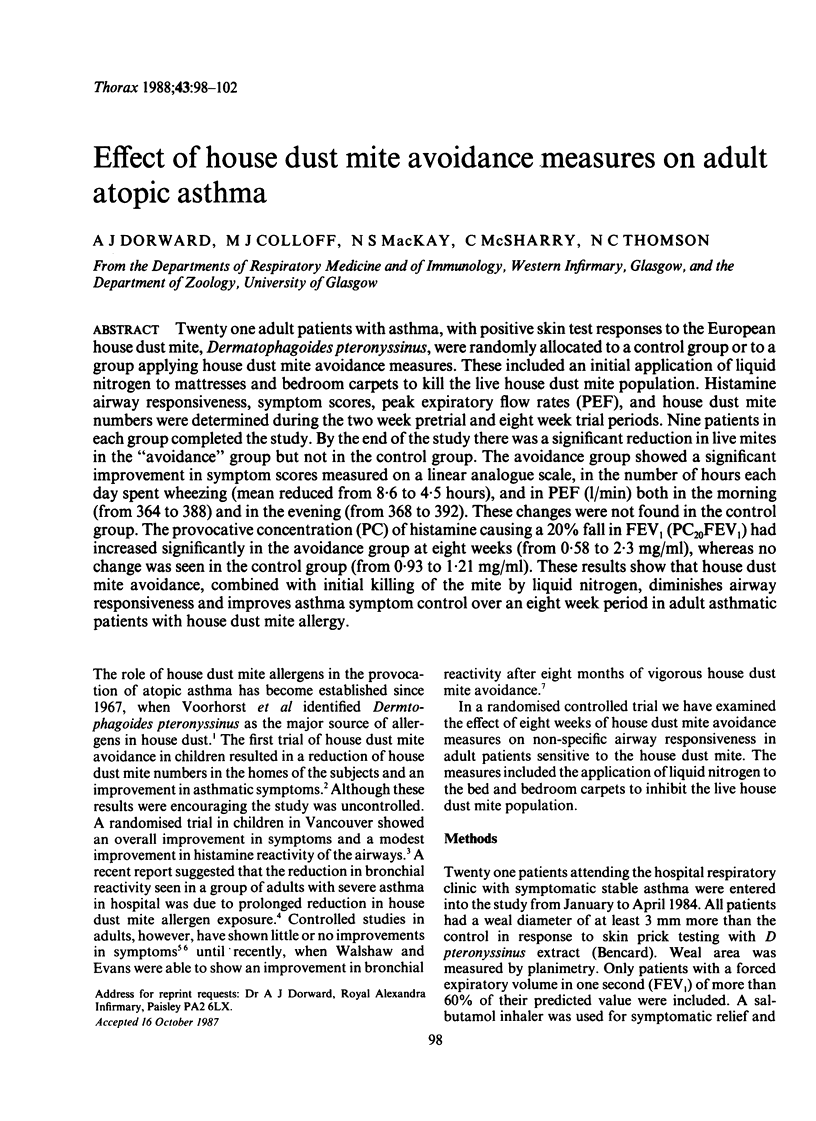
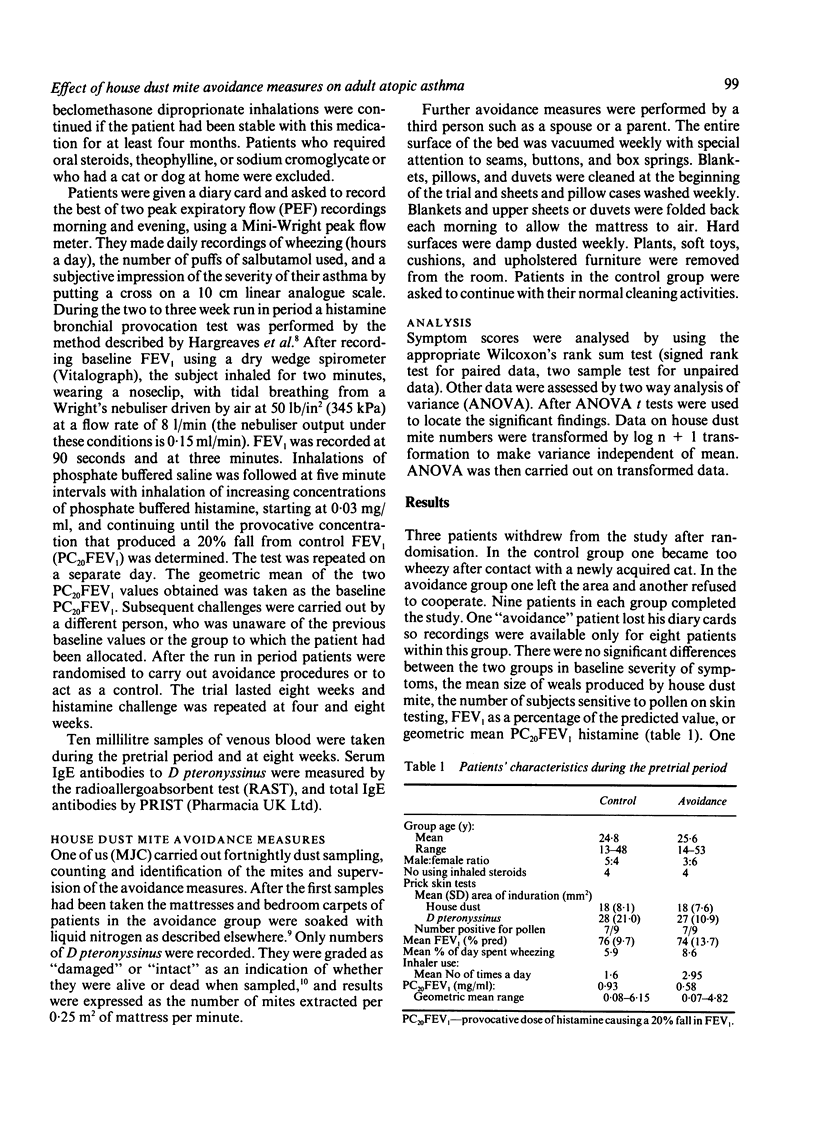
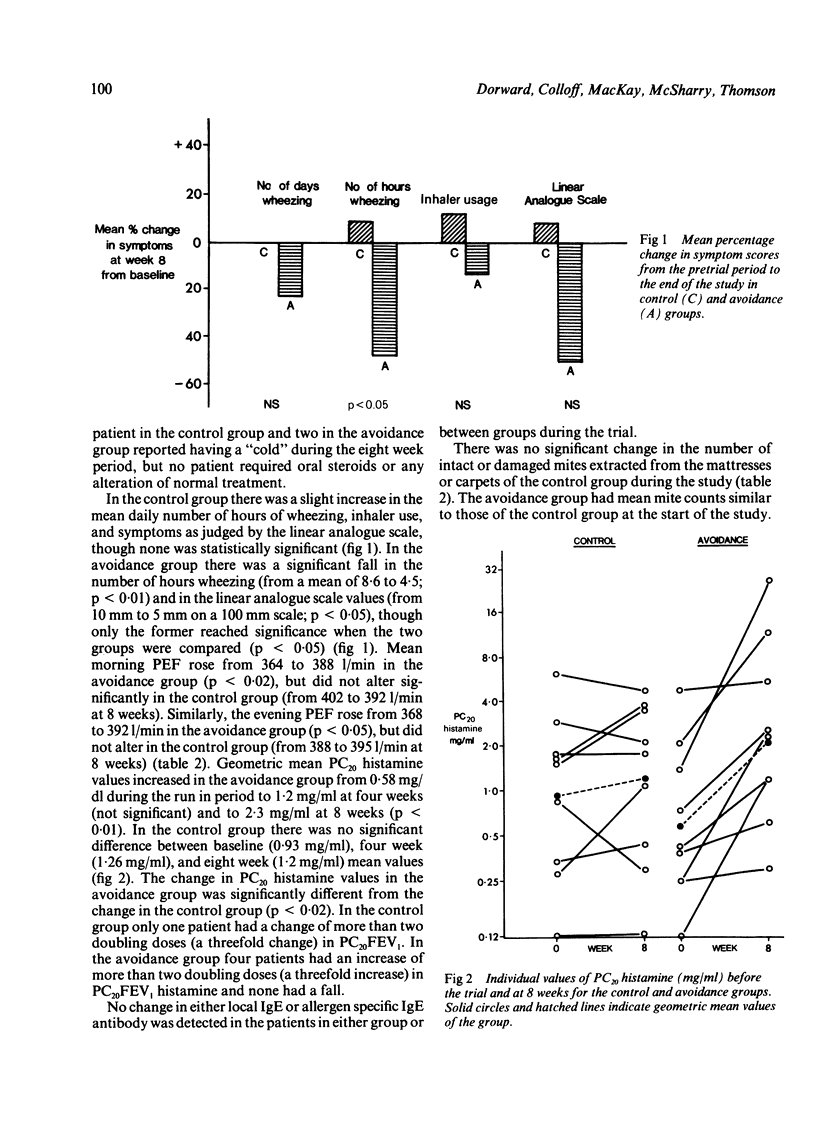
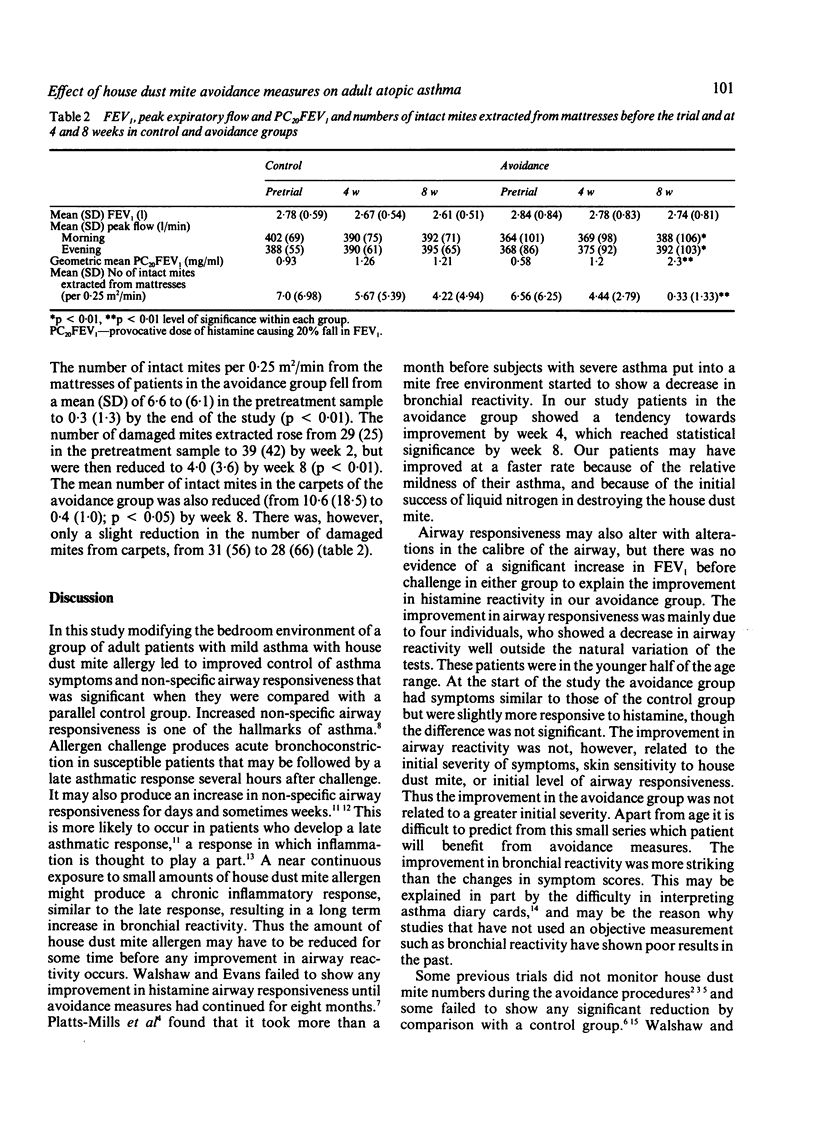
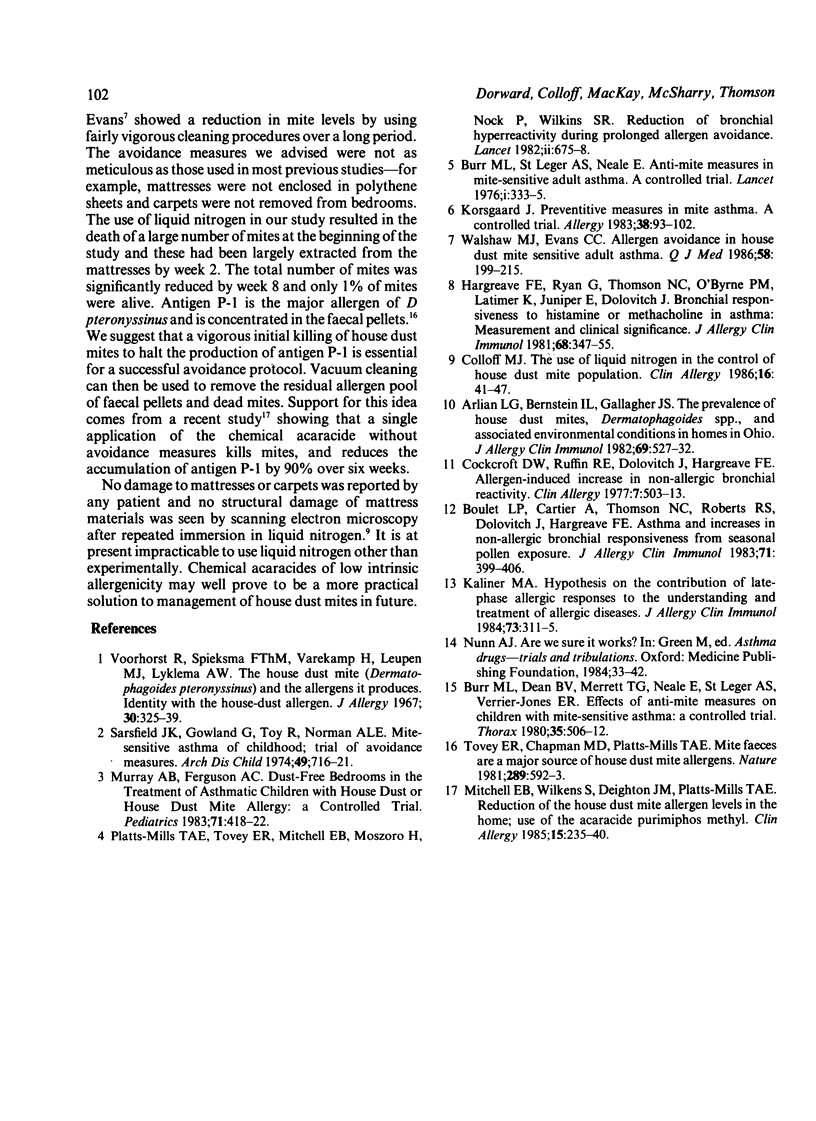
Selected References
These references are in PubMed. This may not be the complete list of references from this article.
- Arlian L. G., Bernstein I. L., Gallagher J. S. The prevalence of house dust mites, Dermatophagoides spp, and associated environmental conditions in homes in Ohio. J Allergy Clin Immunol. 1982 Jun;69(6):527–532. doi: 10.1016/0091-6749(82)90178-6. [DOI] [PubMed] [Google Scholar]
- Boulet L. P., Cartier A., Thomson N. C., Roberts R. S., Dolovich J., Hargreave F. E. Asthma and increases in nonallergic bronchial responsiveness from seasonal pollen exposure. J Allergy Clin Immunol. 1983 Apr;71(4):399–406. doi: 10.1016/0091-6749(83)90069-6. [DOI] [PubMed] [Google Scholar]
- Burr M. L., Dean B. V., Merrett T. G., Neale E., St Leger A. S., Verrier-Jones E. R. Effects of anti-mite measures on children with mite-sensitive asthma: a controlled trial. Thorax. 1980 Jul;35(7):506–512. doi: 10.1136/thx.35.7.506. [DOI] [PMC free article] [PubMed] [Google Scholar]
- Burr M. L., St Leger A. S., Neale E. Anti-mite measurements in mite-sensitive adult asthma. A controlled trial. Lancet. 1976 Feb 14;1(7955):333–335. doi: 10.1016/s0140-6736(76)90086-6. [DOI] [PubMed] [Google Scholar]
- Cockcroft D. W., Ruffin R. E., Dolovich J., Hargreave F. E. Allergen-induced increase in non-allergic bronchial reactivity. Clin Allergy. 1977 Nov;7(6):503–513. doi: 10.1111/j.1365-2222.1977.tb01481.x. [DOI] [PubMed] [Google Scholar]
- Colloff M. J. Use of liquid nitrogen in the control of house dust mite populations. Clin Allergy. 1986 Jan;16(1):41–47. doi: 10.1111/j.1365-2222.1986.tb01952.x. [DOI] [PubMed] [Google Scholar]
- Hargreave F. E., Ryan G., Thomson N. C., O'Byrne P. M., Latimer K., Juniper E. F., Dolovich J. Bronchial responsiveness to histamine or methacholine in asthma: measurement and clinical significance. J Allergy Clin Immunol. 1981 Nov;68(5):347–355. doi: 10.1016/0091-6749(81)90132-9. [DOI] [PubMed] [Google Scholar]
- Kalinen M. Hypotheses on the contribution of late-phase allergic responses to the understanding and treatment of allergic diseases. J Allergy Clin Immunol. 1984 Mar;73(3):311–315. doi: 10.1016/0091-6749(84)90401-9. [DOI] [PubMed] [Google Scholar]
- Korsgaard J. Preventive measures in mite asthma. A controlled trial. Allergy. 1983 Feb;38(2):93–102. doi: 10.1111/j.1398-9995.1983.tb01592.x. [DOI] [PubMed] [Google Scholar]
- Mitchell E. B., Wilkins S., Deighton J. M., Platts-Mills T. A. Reduction of house dust mite allergen levels in the home: use of the acaricide, pirimiphos methyl. Clin Allergy. 1985 May;15(3):235–240. doi: 10.1111/j.1365-2222.1985.tb02280.x. [DOI] [PubMed] [Google Scholar]
- Murray A. B., Ferguson A. C. Dust-free bedrooms in the treatment of asthmatic children with house dust or house dust mite allergy: a controlled trial. Pediatrics. 1983 Mar;71(3):418–422. [PubMed] [Google Scholar]
- Platts-Mills T. A., Tovey E. R., Mitchell E. B., Moszoro H., Nock P., Wilkins S. R. Reduction of bronchial hyperreactivity during prolonged allergen avoidance. Lancet. 1982 Sep 25;2(8300):675–678. doi: 10.1016/s0140-6736(82)90709-7. [DOI] [PubMed] [Google Scholar]
- Sarsfield J. K., Gowland G., Toy R., Norman A. L. Mite-sensitive asthma of childhood. Trial of avoidance measures. Arch Dis Child. 1974 Sep;49(9):716–721. doi: 10.1136/adc.49.9.716. [DOI] [PMC free article] [PubMed] [Google Scholar]
- Tovey E. R., Chapman M. D., Platts-Mills T. A. Mite faeces are a major source of house dust allergens. Nature. 1981 Feb 12;289(5798):592–593. doi: 10.1038/289592a0. [DOI] [PubMed] [Google Scholar]
- Walshaw M. J., Evans C. C. Allergen avoidance in house dust mite sensitive adult asthma. Q J Med. 1986 Feb;58(226):199–215. [PubMed] [Google Scholar]


